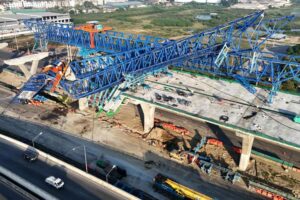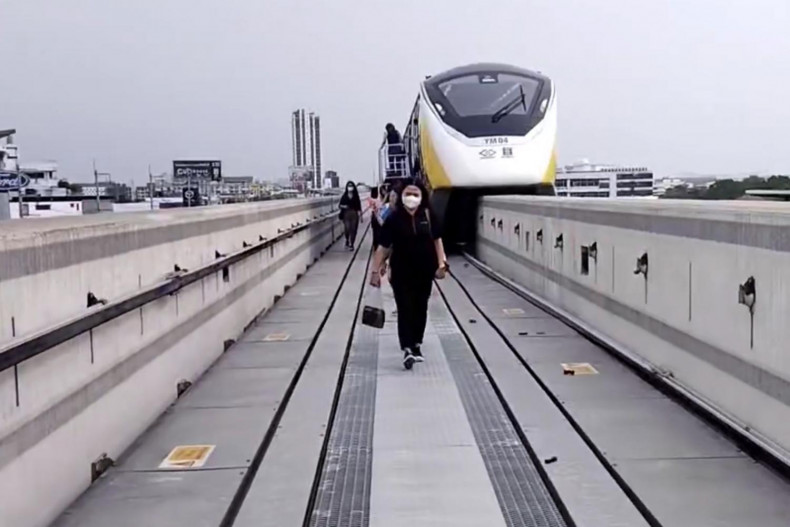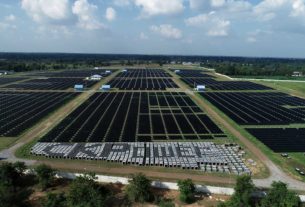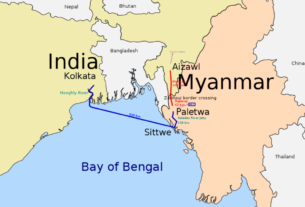
Troubled times for Thailand’s transport sector
Mishaps and misfortunes cast a shadow over the government’s attempts to get the nation moving more efficiently.
1. Bumpy ride for fledgling Yellow Line
Less than half a year since the Yellow Line monorail system began operation in July, 2023, news of a high-profile breakdown hit the media.
Around the end of 2024 New Year celebrations, a wheel of a Yellow Line train fell off, and landed on a taxi near Si Thepha station on Theparak Road in Samut Prakan.
Fortunately, no one was hurt, though the accident stretched public confidence in the safety of the system.
It followed a previous incident with its twin monorail system, the Pink Line, in which the line’s conductor rail fell causing similar damage on Dec 24, 2023.
On March 28 another incident followed. A finger plate installed on the rail expansion joint slipped, causing the plate and other debris to fall between Kalantan and Si Udom stations in Bangkok.
Despite these unusual incidents with the Yellow Line, the number of passengers using the service has remained steady, as electric rail transport still is a faster commuting option, particularly during rush hour.
That explains why the Pheu Thai Party-led government has come up with a policy to cap the cost of travelling on the city’s electric rail network at 20 baht per trip.
Now in effect on the Purple and Red Lines only, the policy is likely to be expanded to cover the rest, amid government plans to begin buying back the electric train concessions so it can fully implement a low-cost transport policy.
Meanwhile, the government has floated imposing a congestion tax on inner city motorists to help fund the promised low-cost electric rail services.
The devastating loss of three lives — one Chinese engineer, one Chinese and one Myanmar worker — when a tunnel at the Thai-Chinese high-speed train project in Pak Chong district of Nakhon Ratchasima caved in during late August has yielded a crucial lesson.

2. Rail tunnel tragedy a bitter lesson
The accident occurred despite China’s extensive experience in building high-speed train systems in its own country, and underlines the importance of extra safety measures for projects here, observers say.
A report attributed the cave-in to specific geological factors. Pichet Kunadhamraks, director-general of the Department of Rail Transport (DRT), said staff would adopt more real-time monitoring of geological conditions at railway sites, particularly underground excavations.
The tunnel where the three were killed is part of the Muak Lek-Lam Takhong section of the project’s first phase.
The high-speed project will connect Bangkok with Nakhon Ratchasima.
Due to finish on June 14, 2025, work on this section is now about 77% complete.
As for good news in the transport sector, the first 420-kilometre section of the southern double-track train system, connecting Nakhon Pathom with Chumphon, opened in June. The line halves the travel time to just a couple of hours.
Work on the 323.10km double-track railroad, connecting Den Chai district in Phrae with Mae Sai district in Chiang Rai, which began on Feb 15, 2023, is also on course to finish with an opening in 2028 as planned.

3. Bus fire exposes shady practices
The tragic Oct 1 bus fire on Vibhavadi Rangsit Road, which claimed the lives of 20 students and three teachers who were on a study trip from Uthai Thani, sparked concerns over sub-standard transport safety.
On Oct 1, six teachers and 39 students from Wat Khao Praya Sangkharam school in Lan Sak district of Uthai Thani were travelling on Vibhavadi Rangsit Road in Pathum Thani’s Lam Luk Ka district when the bus crashed and caught fire. The fire killed 20 students and three teachers and left three others seriously injured.
The vehicle belonged to Sing Buri-based Chinnaboot Tour. The driver, Samarn Chanphut, 48, fled the scene before surrendering later. An inspection of the ill-fated bus concluded a gas leak was the cause.
The bus had 11 tanks containing compressed natural gas (CNG), and a fuel line, which carries gas from a tank to the engine, had come loose, causing the leak. Six of the 11 CNG tanks installed on the bus were registered, while the others were not.
The incident prompted the Department of Land Transport (DLT) to order all 13,426 chartered buses using CNG to be inspected within 60 days. As of Nov 22, 7,484 of them had passed the safety inspection while 1,531 failed and were ordered off the road. The rest had yet to be inspected.
The Transport Ministry has also imposed a temporary ban on the use of buses using CNG to take students on trips pending proper safety measures from the DLT.
In another safety boost, the central committee on land transport on Nov 11 approved a measure requiring large chartered buses to have at least one attendant on board starting from Dec 9.
The rule requires 21-seater buses or larger, hired for excursions catering to students and the elderly, to have at least one on-board attendant per trip to ensure safety in case of an emergency.

4. Rama II’s safety record appals motorists
For those travelling south from Bangkok, mere mention of Rama II Road evokes unease. Known for constant traffic jams and endless roadwork, it is also notorious for frequent accidents related to construction projects.
The latest tragedy occurred at 4am on Nov 29 when a launching gantry crane and precast concrete segments collapsed at a section of the elevated Ekkachai-Ban Phaeo Intercity Motorway 82 (M82) in Khok Krabue sub-district of Samut Sakhon’s Muang district. The accident claimed six lives and injured nine others.
Rama II Road, officially known as Highway 35 (Thon Buri-Pak Tho), spans 84 kilometres, connecting Bangkok to Ratchaburi’s Pak Tho district.
Since its opening in 1973, it has been plagued with never-ending construction projects, including a project to expand the road to 10 traffic lanes.
Currently, a motorway is being built above the highway to provide an alternative route to those travelling to the South.
Between 2018 and January 2024, 2,242 accidents were recorded on Rama II Road, resulting in 132 deaths and 1,305 injuries. Public outcry has intensified, calling for stricter safety measures and accountability.
Transport Minister Suriya Jungrungreangkit admitted penalties for contractors are too meagre. Small fines have failed to deter them from safety violations.
The government now plans to implement a contractor performance record to impose stricter penalties, including fines, score deductions and suspension from future projects. However, creating and enforcing these regulations will take time.
Recurring accidents have pushed the completion deadline for projects on Rama II Road from June to September 2025.
Meanwhile, the public must navigate a dangerous road, uncertain of when safety improvements will materialise. Until then, road users will have to face the risks posed by inefficiency and poor oversight.

5. Airport terminal rare bright spot
Amid troubling news about transport accidents, Thailand’s air travel sector has been a bright spot this year, with Suvarnabhumi Airport’s Midfield Satellite 1 (SAT-1) terminal receiving a Prix Versailles award for exceptional exterior design at the Unesco headquarters in Paris in December.
SAT-1 terminal showcases Thai cultural identity and uniqueness through sculptures that welcome travellers. The building also incorporates a sustainable design that promotes energy efficiency and corresponds with the green airport policy.
Opened in September last year, the SAT-1 terminal is aimed at boosting the airport’s passenger-handling capacity to 60 million per year, up from 45 million. With the third runway opening in October this year, the airport is capable of accommodating 94 flights per hour, an increase from 68 flights.
The four-storey high facility has two underground floors, occupying a total indoor usable area of 251,400 square metres and an apron area of more than 260,000m².
The Prix Versailles award has reinforced the Airports of Thailand’s (AoT) efforts to elevate airport services to achieve the vision of transforming Thailand into a regional aviation hub.
About 119 million passengers travelled to Thailand this year with the number projected to rise to 130 million next year.
Suvarnabhumi airport has an expansion plan to accommodate an additional 15 million passengers, raising its total capacity to 80 million. The bidding process for the project is planned for February next year.
Also, Suvarnabhumi airport staff have also won praise for their ability to respond to emergency situations.
On May 21, Singapore Airlines flight SQ321, with 211 passengers and 18 crew, was forced to make an emergency landing at the airport after experiencing severe air turbulence.
As soon as the aircraft landed, a rescue operation began, assisting all passengers and crew and taking the injured to nearby hospitals for treatment.
Six people suffered severe injuries, 39 had moderate injuries, while the rest suffered minor injuries on the London-Singapore flight, during which a 73-year-old British man died of a suspected heart attack. Praise poured in for the professionalism of all those involved in responding to the incident.
Source: https://www.bangkokpost.com/thailand/general/2929692/troubled-times-for-transport-sector


